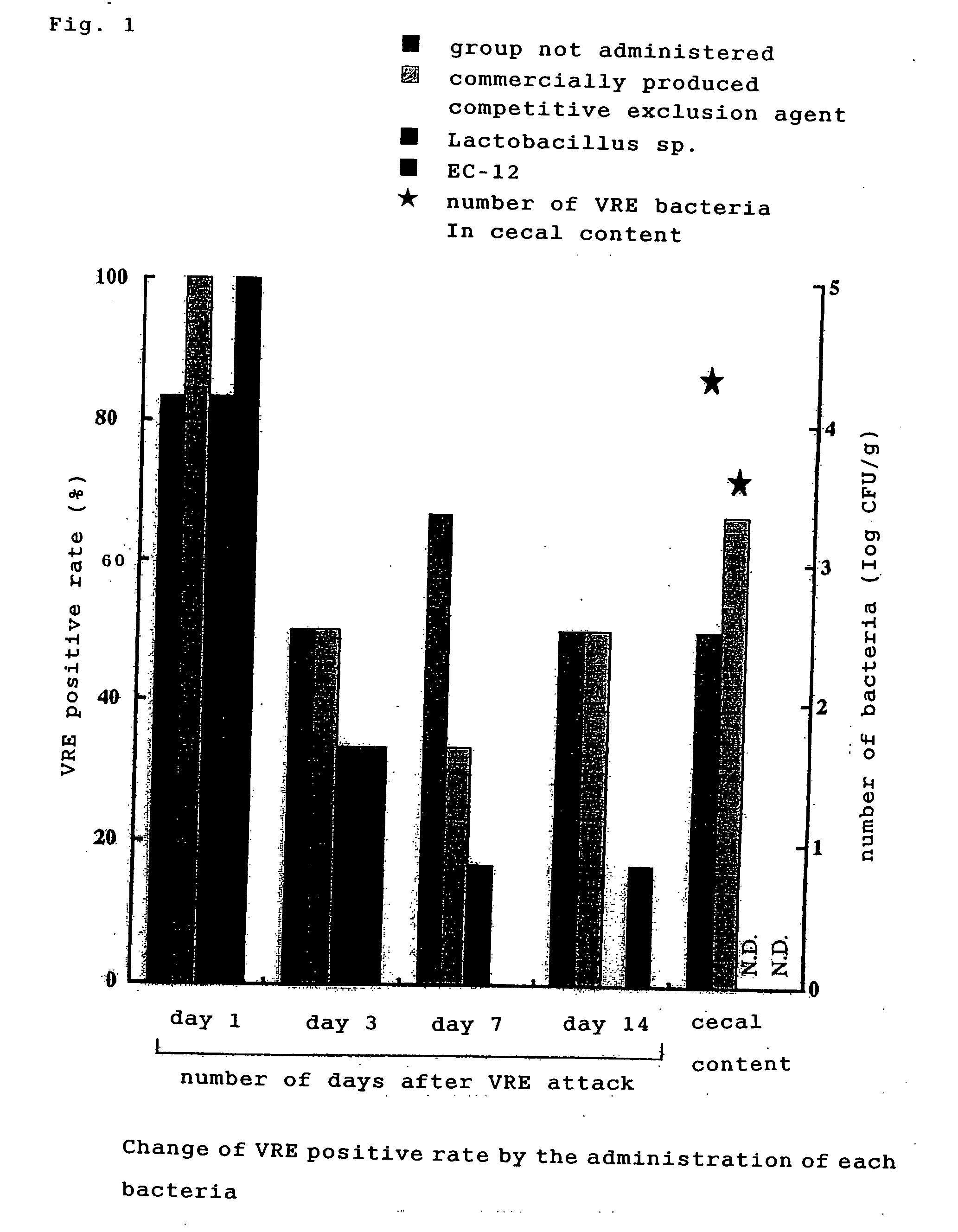Preventing agent against drug-resistant bacterial infection
a technology of antibiotics and bacteria, applied in the direction of antibacterial agents, bacteria material medical ingredients, antibacterial agents, etc., can solve the problems of resistance bacteria to fluoroquinolone, disease cannot be completely cured or cured in a long time, and disease cannot be easily cured, so as to prevent drug-resistant bacterial infection in human body
- Summary
- Abstract
- Description
- Claims
- Application Information
AI Technical Summary
Benefits of technology
Problems solved by technology
Method used
Image
Examples
example 1
(Preparation of Dead Bacteria of Enterococcus faecalis EC-12)
[0035]Enterococcus faecalis EC-12 (IFO 16803) was cultured in a Rogosa medium at 37° C. for 24 hours. The culture solution was inoculated in an amount of 0.1 (v / v) % to a liquid medium containing 4% yeast extract, 3% polypepton, and 10% lactose. By adjusting the pH to 6.8-7.0 by using sodium hydroxide with a pH stat, neutralizing culture was performed at 37° C. for 22-24 hours.
[0036] After the culture has completed, the bacteria were separated with a continuous centrifuge and collected. Then, water was added to dilute up to the original liquid level, and the bacteria were separated again with a continuous centrifuge, and collected. This operation was carried out 4 times to wash the bacteria. Then, the washed bacteria were suspended in an appropriate water level, sterilized at 100° C. for 30 min, and dried by using a spray drier to prepare a heat treated bacteria powder.
example 2
(Infection Test of Human-Derived VRE)
[0037] Bacterial culture of 2 VRE bacteria strain (2 strains of human-derived standard bacteria) was forcibly administered orally in an amount of about 108 / chick to 1 day-old VRE-free broiler chicks (2 groups, 6 chicks per group). At day 0.5, 1, 3, 7 and 14 after administration, fecal swabs were collected, and smeared to an EF agar medium supplemented with 10 μl / mL of Vancomycin (VCM). The resultant was cultured at 37° C. for 48 hours, the grown colony was collected, and was identified to belong to Enterococcus, from its Gram staining, morphology, and fermenting ability. At day 21 after administration, the chicks were dissected and the colonization to each gastrointestinal tracts including crop, stomach, small intestine and cecum was examined. As a result, VRE was isolated from all swabs of day 0.5 to 14 after administration, while at day 21 after administration, VRE was isolated from all gastrointestinal tracts including crop, stomach, small i...
example 3
(Inhibition Effect of VRE Colonization in Intestinal Tract)
[0038] 1 day-old VRE-free broiler chicks were used (4 groups, 6 chicks per group). Four groups were made as follows: control group not administered; group administered with dead lactic acid bacteria powder (EC-12)-added feed; group forcibly administered orally with chicken fecal-derived Lactobacillus sp.; and group spray-administered with commercially produced Aviguard (competitive exclusion agent; Bayer). Lactobacillus sp. was forcibly administered once at the time of 1 day-old. A competitive exclusion agent was administered by spraying at the time of 1 day-old. EC-12 was administered by adding to the basic feed, in an amount of 0.05% from the time of 1 day-old until the time of examination by dissection. VRE strain whose colonization to intestinal tract was confirmed in Example 2, was forcibly administered orally to all of 2 days-old chicks. At days 1, 3, 7 and 14 after VRE attack (infection), fecal swabs were collected ...
PUM
| Property | Measurement | Unit |
|---|---|---|
| v/v | aaaaa | aaaaa |
| v/v | aaaaa | aaaaa |
| v/v | aaaaa | aaaaa |
Abstract
Description
Claims
Application Information
 Login to View More
Login to View More - R&D
- Intellectual Property
- Life Sciences
- Materials
- Tech Scout
- Unparalleled Data Quality
- Higher Quality Content
- 60% Fewer Hallucinations
Browse by: Latest US Patents, China's latest patents, Technical Efficacy Thesaurus, Application Domain, Technology Topic, Popular Technical Reports.
© 2025 PatSnap. All rights reserved.Legal|Privacy policy|Modern Slavery Act Transparency Statement|Sitemap|About US| Contact US: help@patsnap.com

